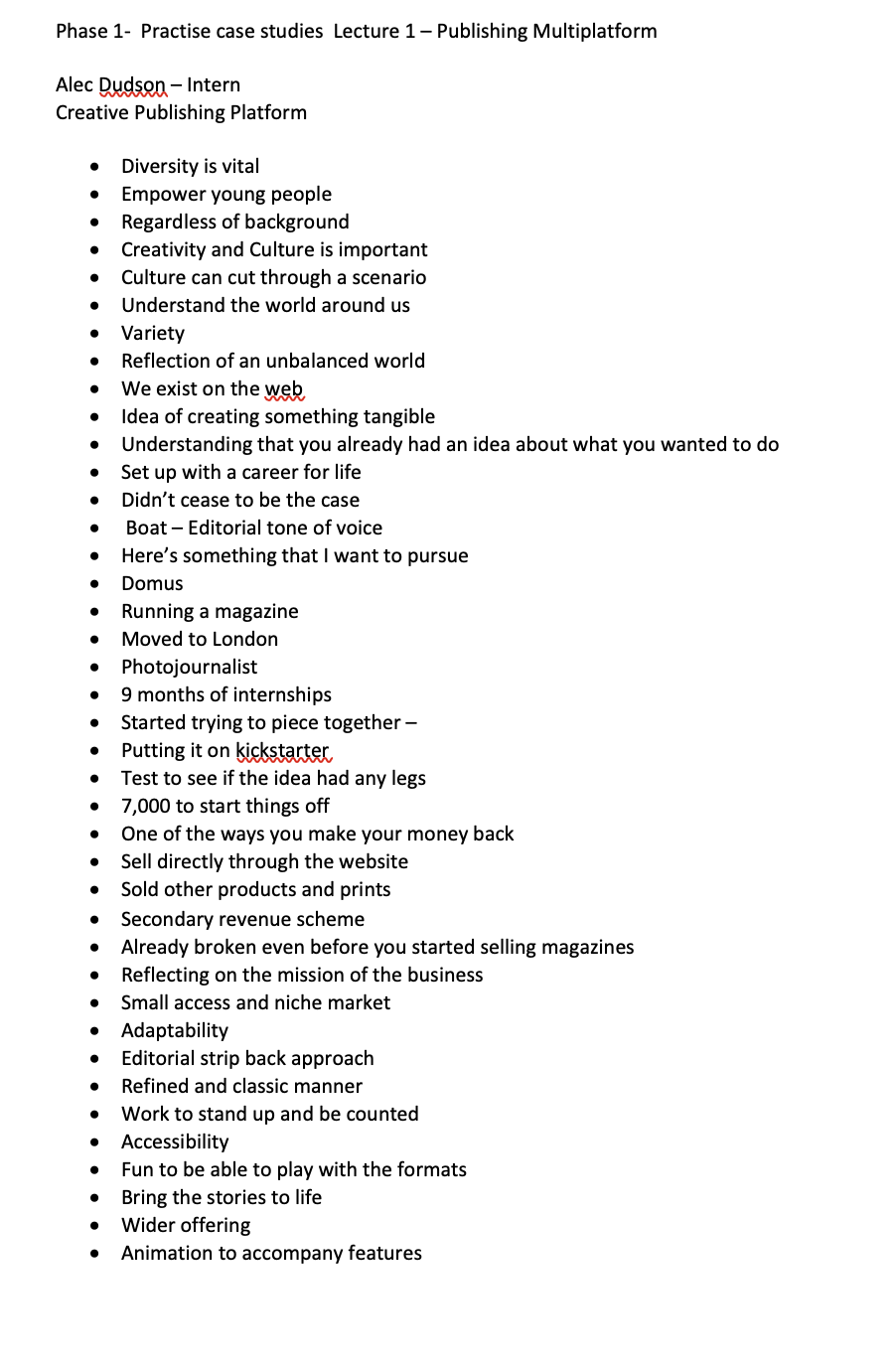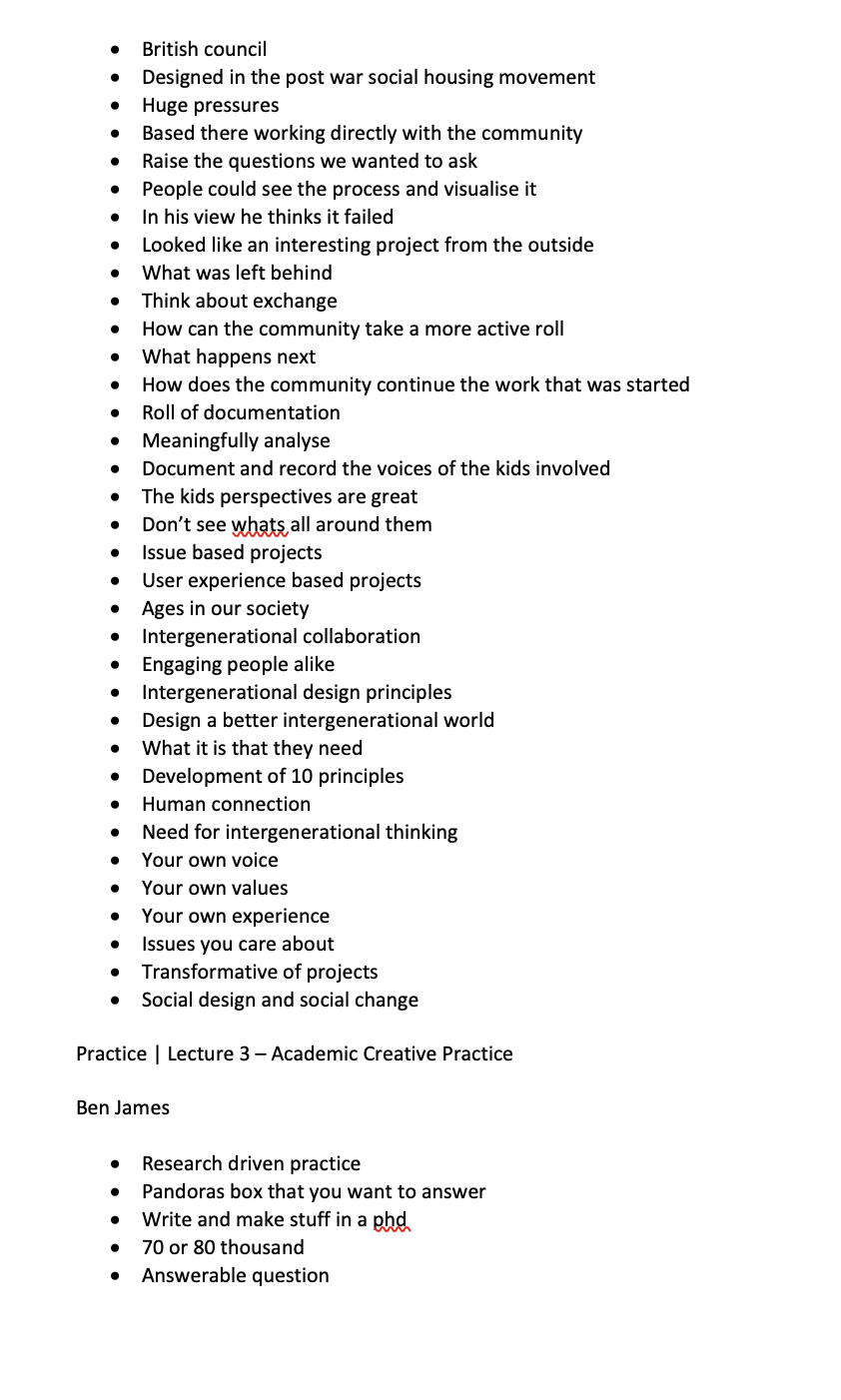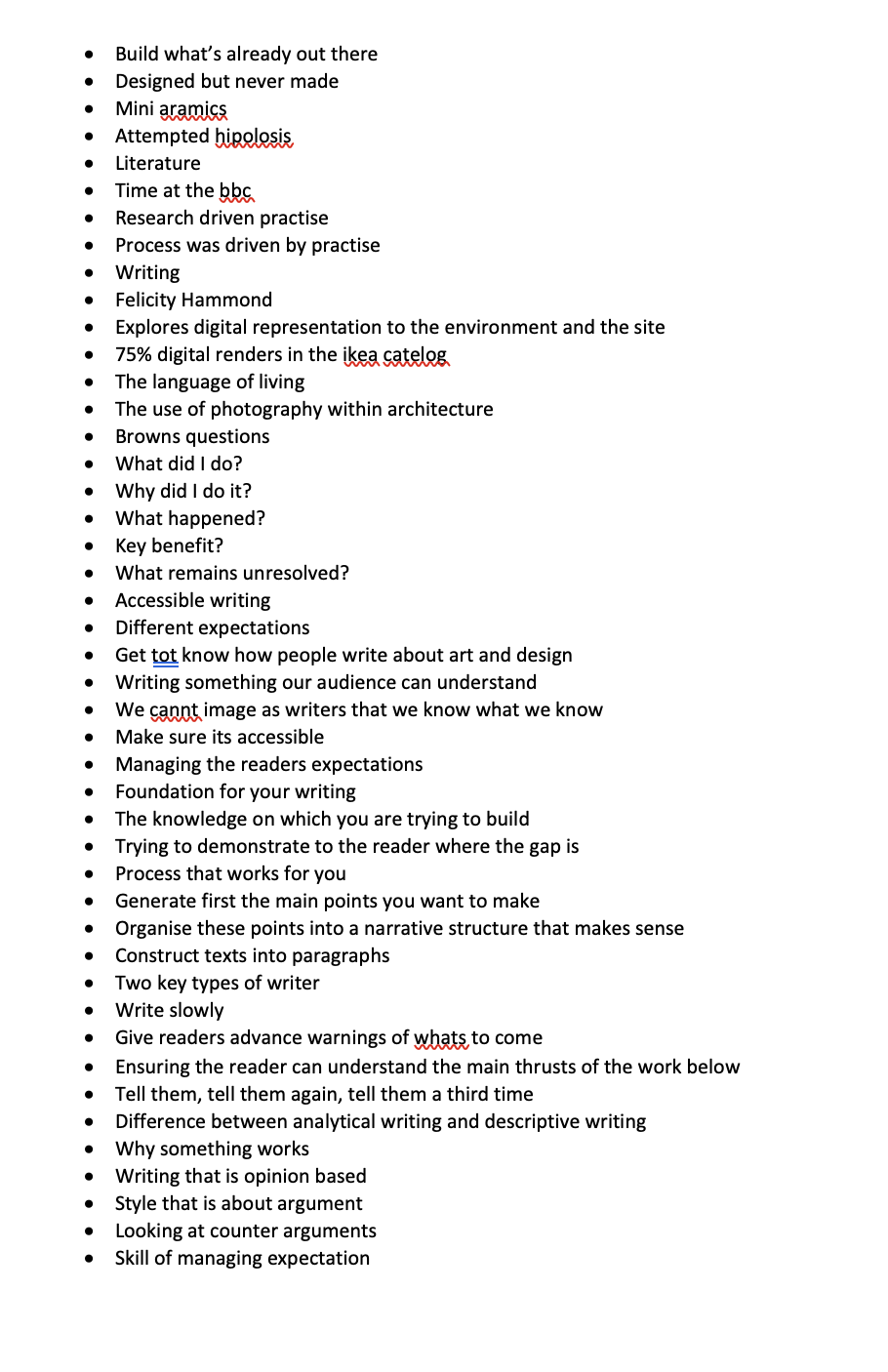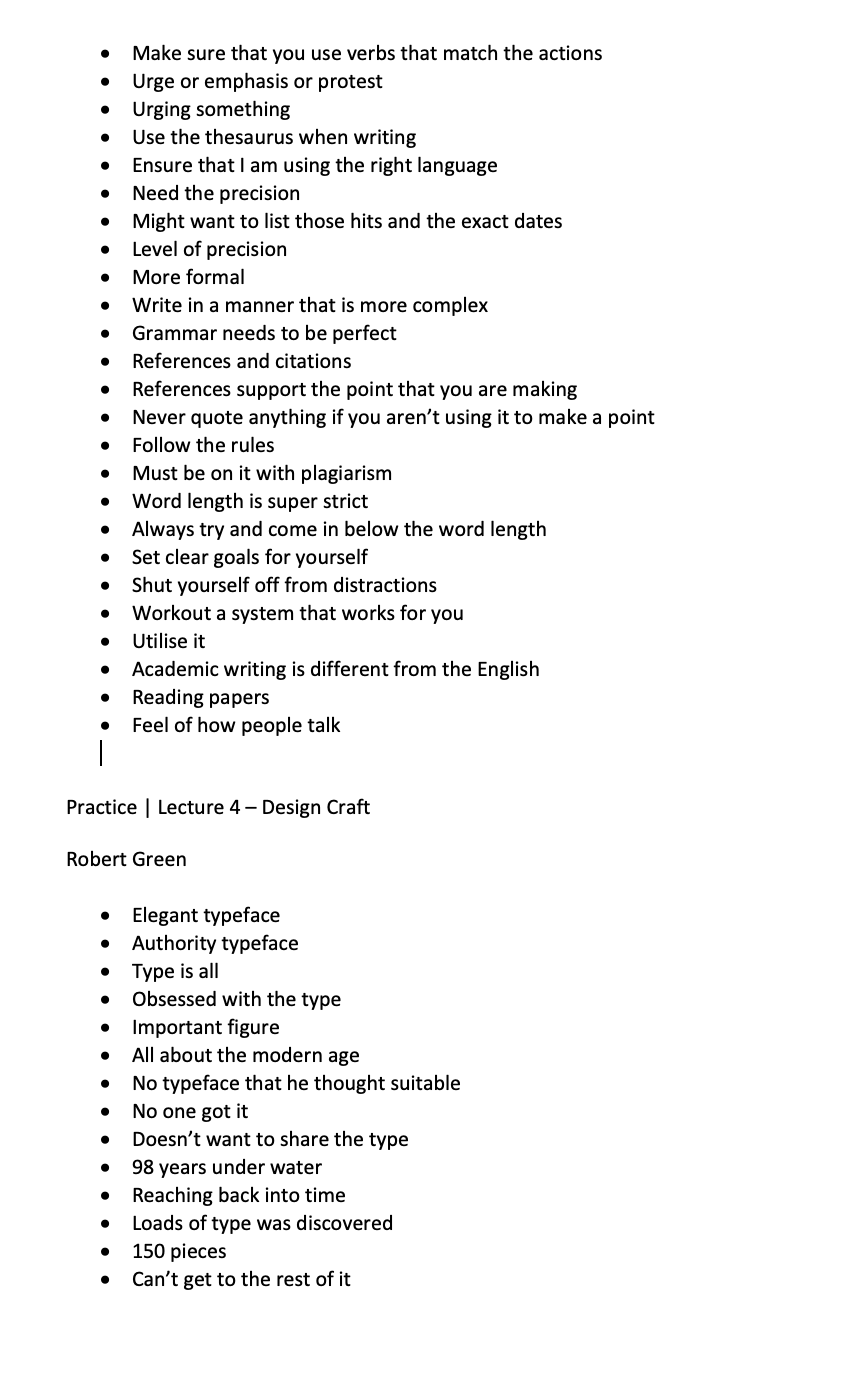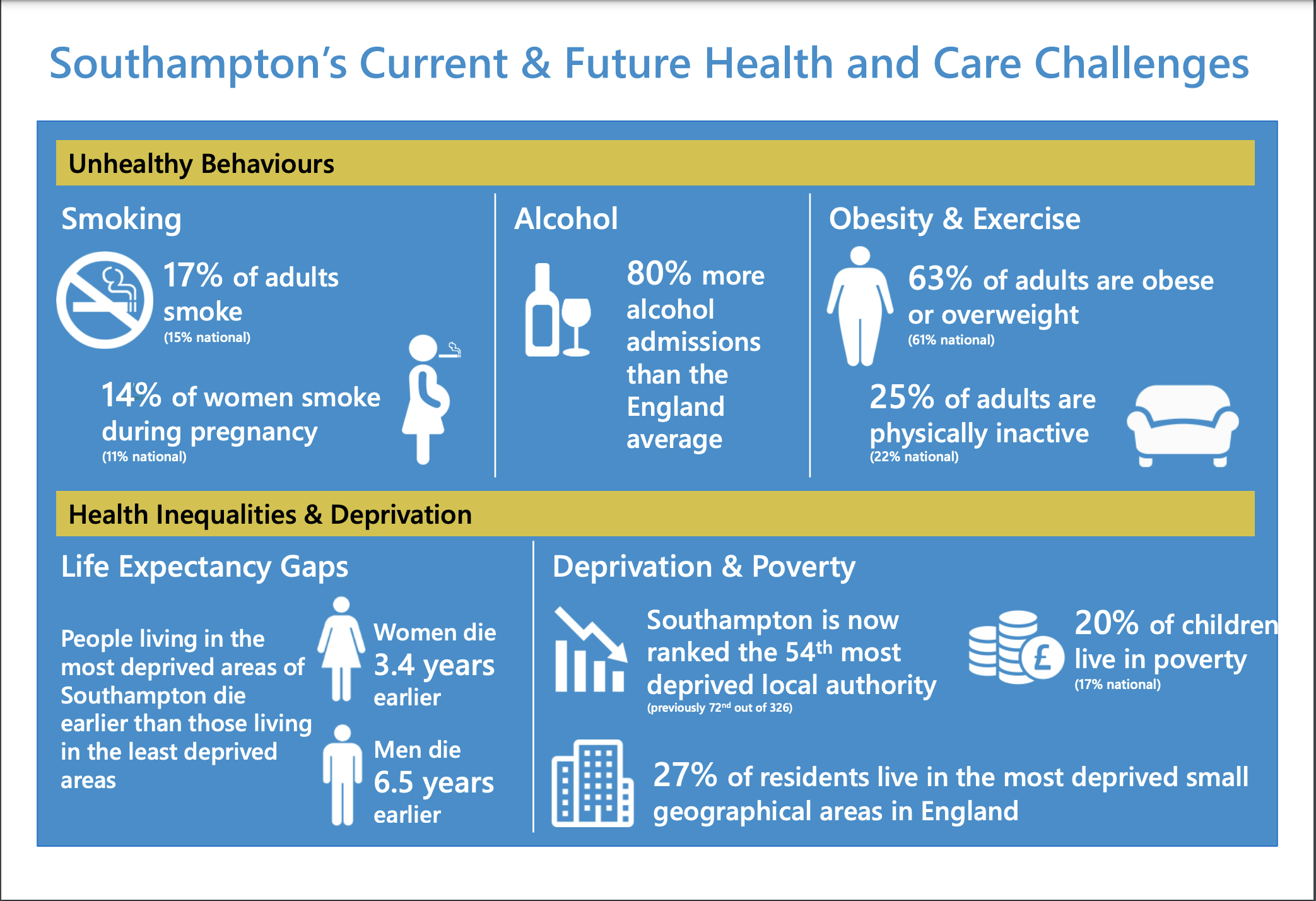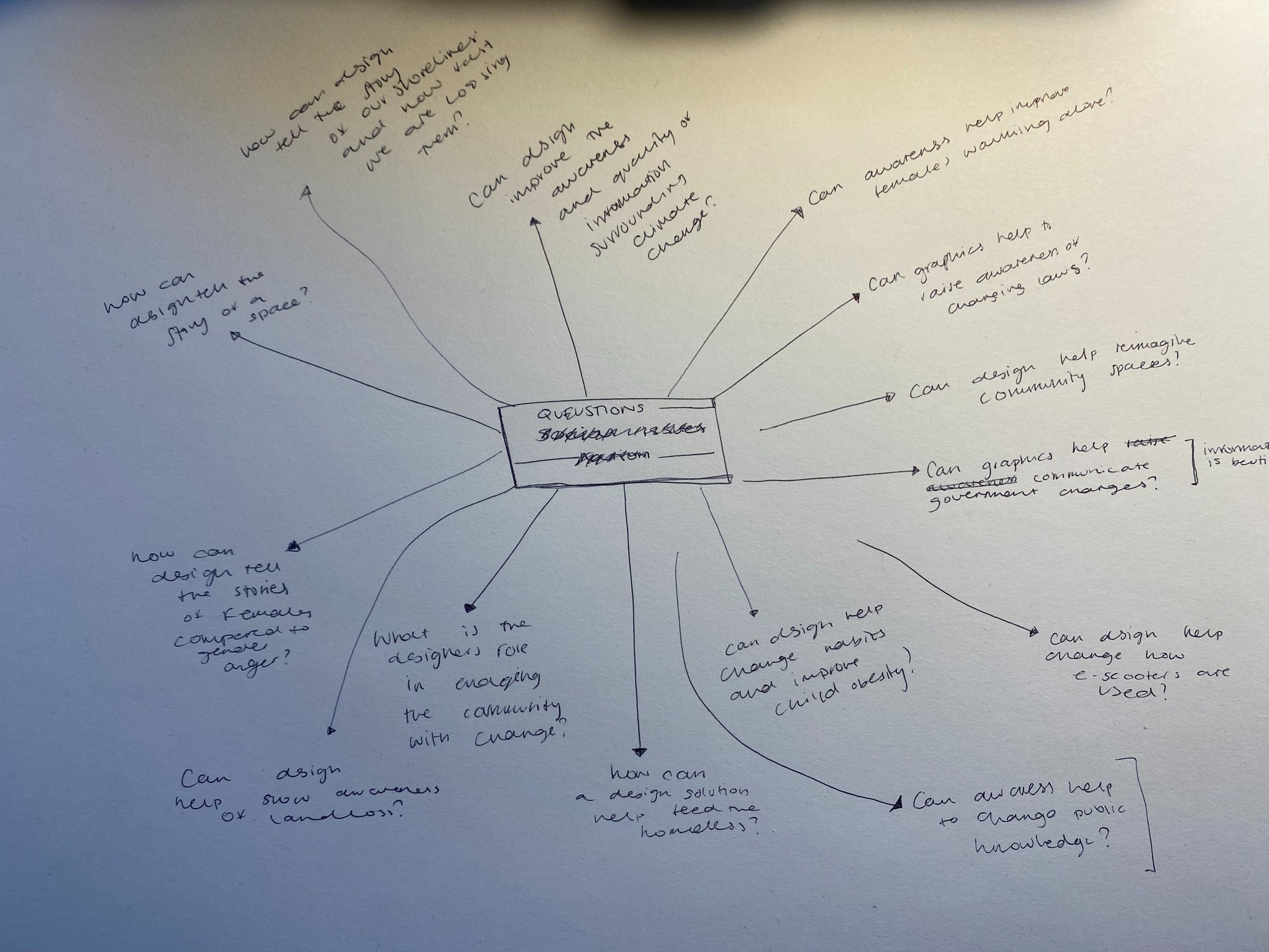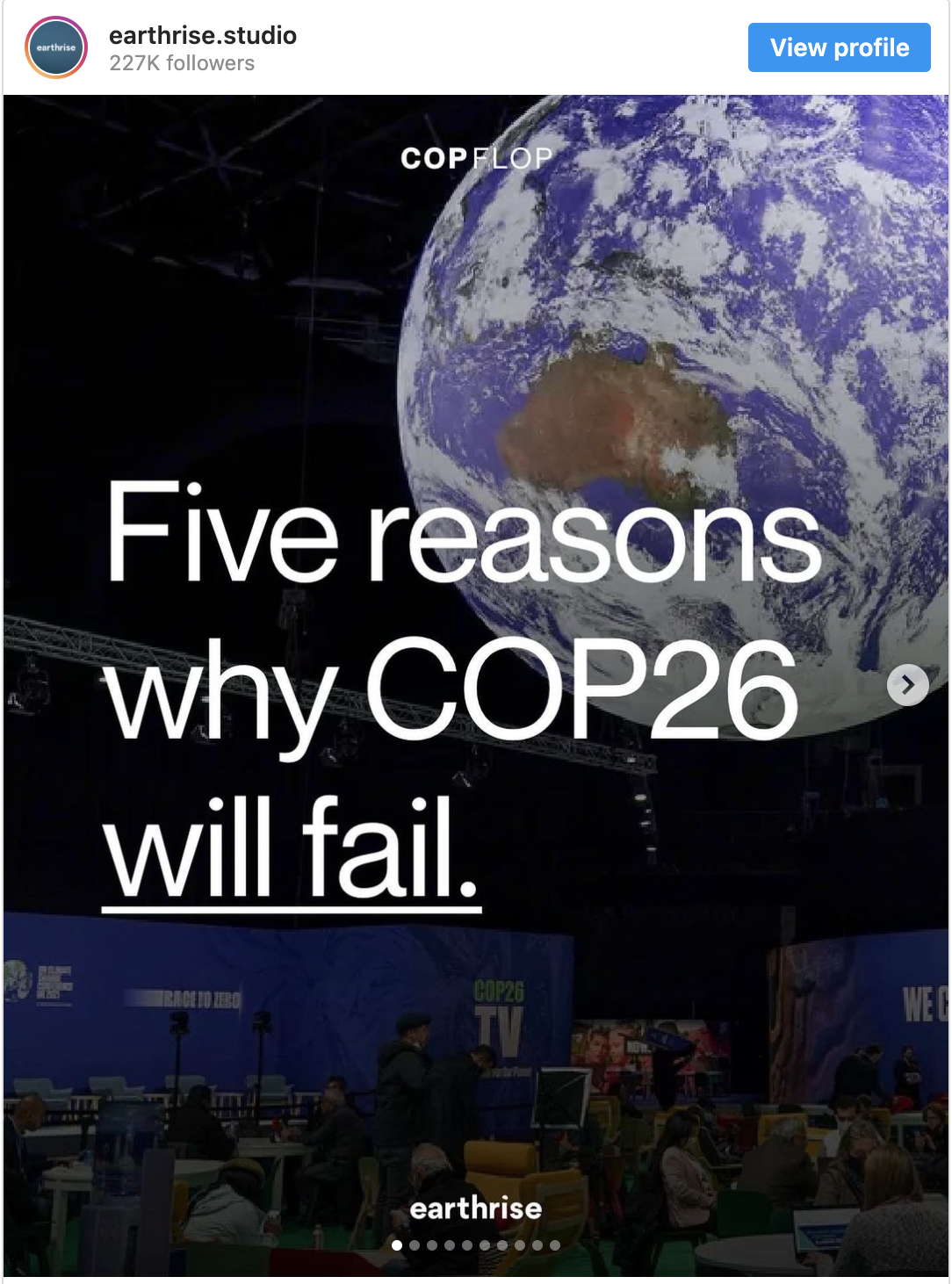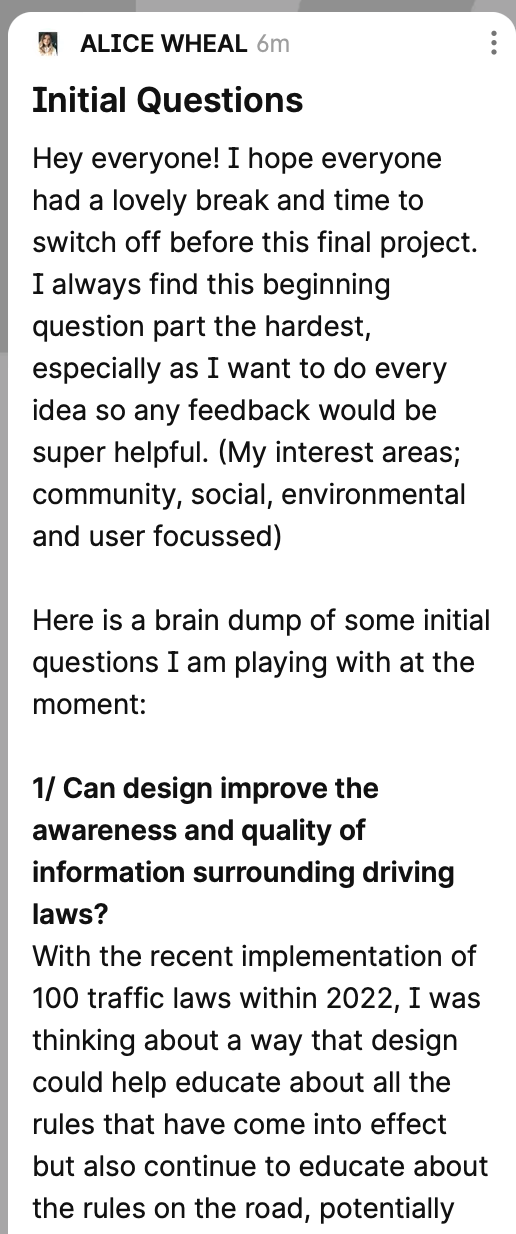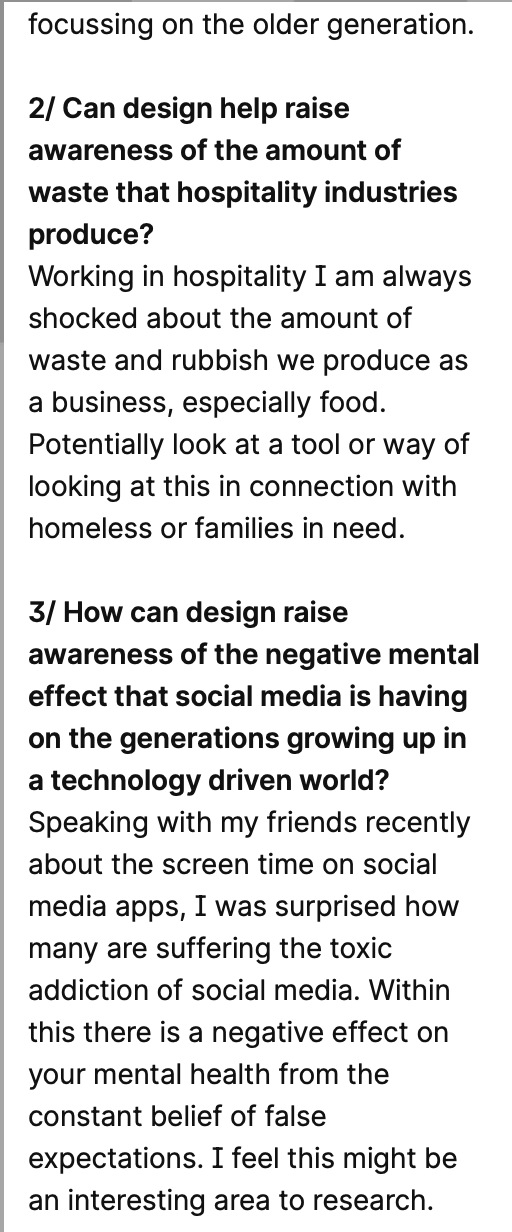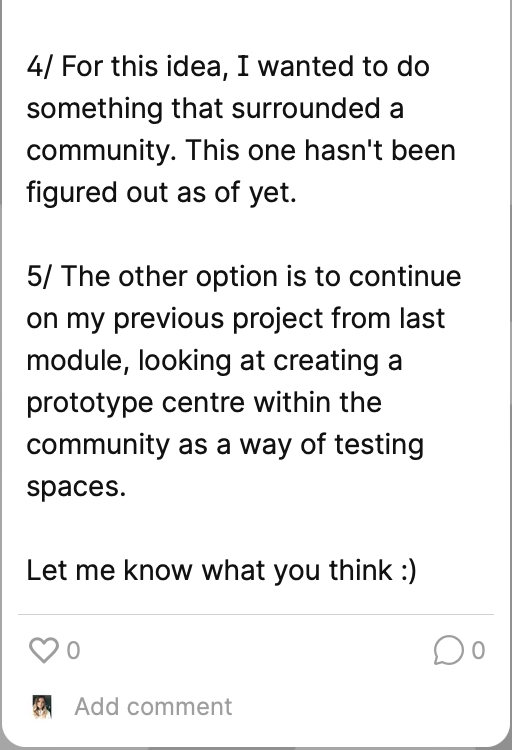Phase 1 - Week One
Practice led case studies
1/ Publishing Multiplatform
Alec Dudson
Dudson spoke about his project called intern within this lecture, something that he had decided to create after his never ending story of never getting a job after internships. I resonated with the work that he creates now and how he is constantly trying to push the boundaries of a typical magazine, branding out into video, moving image and podcasts. He has also created this educational part to his website where he teaches graphic designers practical skills that you often aren’t taught as part of the course. Dudson has managed to create a narrative at intern that has enabled him to create a cohesive brand whilst still being able to take on research that allows him to move forward as a business.
2/ Social Change
Joseph Pochodzaj
I connected with this lecture with Pochodzaj, as he spoke about his social projects over the years since he completed his masters. I especially like the point he made about finding a social project which is very relevant to this weeks body of research; ‘who do you think you are, knowing your own values is the basis of your project, look around you, what are the issues that are affecting those who are close to you, seek the unseen and uncover the truth’. Throughout the lecture Pochodzaj created a beautiful graphical outlay for each of the projects he uncovered, within these projects, was one that looked at political speeches and how the news is portraying language and the human voice. In the end he created these saying and newspapers with these words on them. Such a simple project that created a large impact. I would love to do an environmental or social project for this module so I will keep his process with me.
3/ Academic Creative Practice
Ben James
With James having been my tutor for the past few modules, I am familiar with some of his body of work that he has completed. Some of the work that he mentioned, for example Felicity Hammond, I have also previously researched as I became a huge fan of the way that she looked at the digital representation of the environment and admire the way that she uses photography within her work. I feel this is something that I should be doing within the research process is photographing the process and research that I undertake. James had some useful points about the writing up of the essay at the end and I will also take on board the browns way of analysing after a project as I feel I need to work on the analysis throughout this project·
What did I do?
Why did I do it?
What happened?
Key benefit?
What remains unresolved?
4/ Design Craft
Robert Green
Uncovering some of the lost type that was thrown of a bridge and under water for 98 years. I thought this was an interesting way of under-covering craft and showing that the projects can last longer if you want them too.
Practise based lecture research
Joseph Pochodzaj
I tried to do some more research on Pochodzaj, but there was limited information that was available about his work. I did really want to highlight the exhibition that he created using the political speeches that he analysed. The exhibition allowed the public to create their own words and sayings by taking down and placing the words in different places. I feel this completed his project and I would love to complete another exhibition design within the outcome for this project.
Whilst researching around the social change that I took from Pochodzaj’s lecture, I found this article on medium that speaks about how to design for social change;
https://medium.com/nyc-design/how-to-design-for-social-change-571a18e70bf5
Within the article there are multiple steps that are taken in order to make design innovations and positive changes (Miller, 2018).
Step One - Define the solution
“What is the issue, who does it affect? what are the social and cultural factors? How do you know this is a problem? Can you think of this problem in a new way?”
The first step is understanding and defining the problem, turning around the assumptions and reframing issues to come up with the solution.
Step Two - Re-Define
Analyse the wider environment ( Alot of maps and frame work materials that would help)
Step Three - Share and Connect
Make Issues Public - Tell stories & Build Networks.
6 Thinking hats
Co design
Reframing
This is a really useful resource, I have only listed the first couple of steps for now as the article goes on to look at the outcomes and prototyping that might be useful later on within the module. I think the initial questions that are under step one will really allow me to engage with my subject area.
Week One
I began this week by starting to come up with some ideas that I thought my final project could be. Already knowing that I have this constant need to look at environmental, social and community change as well as looking at the things I enjoy such as spacial design, photography, graphics, architecture. I tried to copy a similar creative process that we went through within GDE740 that allowed me to come up with some ideas for the self initiated project.
I went back through and looked at previous projects that I enjoyed;
Archive Project:
This was a project that I completed in Module 3, surrounding creating an artefact. I ended up collaborating with my granddad about his many fascinating stories he has from exploring the globe as a metrologist.
To expand this project, I could go on to create a physical exhibition space that I could expand taking stories from other people around the world too.
Spacial Project
Within module 4, I ended up creating a project that looked at reusing an abandoned space within the park that closest to me. I wanted this space to be a prototype environment that would then allow the council to listen to the communities Ideas with the redevelopment of the rest of the park. As this was just the planning stage of the project, I could take this further by involving some of the council members as well as doing focus groups with the local community.
Process:
This project I really enjoyed which i called the great exchange which allowed for people to collaborate remotely across the globe. I created the outputs as well as the platform that would host the great exchange. If I was going to expand this, I would look at a larger scale and bringing the great exchange physical.
Environmental:
I have always tried to be a sustainable designer where possible, so I would like to try to base a project around this. This example is from module one about raising awareness of of the water pollution that is affecting everyone world wide. I really liked this experimental approach and If i was going to take this project further I would look at more local places to implement.
So as a recap, after reviewing through the work that I have completed up to know the main projects that I enjoyed and I thought I could extend were:
Archive Project
Cycle Project
Spacial Project
Abstract project
Process Project
Pleasure Park project
All of which I think could be extended or expanded and focussed with a target audience as well as involving the local community.
I began to create a series of mindmaps that would allow me to explore different research questions, what I was interested in and what I thought might need doing:
The first mind map just had all the ideas on what the questions could be based around:
I then used a technique that I’ve used in previous modules before with &Walsh (Walsh, n.d.), I went through and listed the things I was passionate about but also things I thought needed improving in the world:
https://andwalsh.com/articles/all/creating-self-initiated-projects/
As &Walsh talks about within the article about coming up with self initiated ideas, I wanted to take some of these ideas that I think need improving and look at the why and expand on the ideas surrounding how I could change and make a difference (Walsh, n.d.):
Recycle of furniture
What can i do about it?
People often view their junk or something that they don’t like in the home anymore which they just throw away. But over the time of the pandemic, it has shown the power of second hand and how many more people were buying through facebook market place. This seems to have slowed down now the pandemic is coming to a close as people seem to have their focus elsewhere than on their homes. I wonder about raising awareness or creating a space where you can up-cycle furniture.
Awareness of climate change
What can i do about it?
Previously done in another module, I looked at raising awareness to the water pollution that we are experiencing globally. There are a number of ways to raise awareness but potentially looking at installations or working closely with a brand to help reach a wider audience.
Sustainable packaging
What can i do about it?
With the increase of online purchases increasing each year, there is still many companies that don’t use recyclable materials within their packaging which is causing more and more pollution and plastics to end up in landfill. Look at designing a packaging that is affordable and that can be used by many different companies.
Abandoned warehouses
What can i do about it?
Across cities there are many building that are left empty, I think telling the story of that building or warehouse within a reimagining of a space could be beneficial and to make use of the space that is already available instead of creating new.
Road Laws
What can i do about it?
Within 2022, there are new road laws that have come into affect that there is basically 0 information on unless you really research for them. I feel this needs to be accessible and people need to be made aware of the need road laws whether this was through an app or infographics.
This exercise allowed me to hone in the issues and what I feel I could change about these ideas. From this, I feel I had a good base of ideas that I could draw from these mind maps. I could come back to these later to explore more.
From a previous project, I looked at the social issues that were within my area and what I could potentially do to help improve them. Being a local to the southampton area, I am aware of the things that need changing that i can see but often some things you cant see. I went back through this research from the local area:
From this article, It looks at the changing social issues within the city but how they want to change this and help change the way that southampton is living.
Among these issues that are shown above, my previous research shows that Southampton’s crime rate is increasing which is a cause for concern among the air pollution that dropped significantly during the lockdown in 2020. Another issues that was highlighted was Child Poverty / Food Banks, The recent school meal problems that happened over lockdown have really highlighted to me how bad child poverty is within Southampton with 1 in 3 children living in poverty. The final issue that was raise was: Child Obesity / Adult Obesity, within Southampton there is a higher obesity rate to the rest of the UK, with a lot of children and adults being inactive. All of this research is really valid and interesting to highlight the social issues within the local area, I wanted to create a visual mind map listing all the social issues:
Doing the same technique as before, I took some of the topics and decided to think about what I could do to change them:
Lack of community spaces
What can i do about it?
Make sure that the use of abandoned buildings enables users to to use them as a community space. Making full use of the building. Creating plans for what they want as a community and the needs.
Female alone
What can i do about it?
Ensure lighting across the city is in check and get lighting where there isn’t. Put a process in place that can allow women to walk alone without the need to be scared.
Mental health
What can i do about it?
There is so much stigma around mental health when actually within the 21st century it is very common of people especially in this toxic driven world. I wonder if there is more mental health within people that use social media? this could be something to look down?
Child obesity
What can i do about it?
Raising awareness and putting in steps that would allow for habits to be changed and broken and healthier habits to be replaced.
E-scooter rights
What can i do about it?
Not many people across the UK know that riding a private e scooter on any public property is illegal. People think that they are helping to save the planet so awareness needs to be done around this.
I also looked at some of the previous university masters submissions to see the amount of work that they have achieved with this project. Looking at their research questions, it seems that they chose a question because thats what they were interested in. After writing down all the what I could do about it above using &Walsh technique, I went onto start to think about how I could lay out the questions differently which can be seen through the mind map and the below questions:
*Can design improve the awareness and quality of information surrounding driving laws?
Can design help raise awareness of Land loss to help us save our planet?
*Can design help raise awareness of the amount of waste that hospitality industries produce?
Can design help to raise awareness of the false information that surrounds the fitness industry?
*How can design raise awareness of the negative mental effect that social media is having on the generations growing up in a technology driven world?
Can design raise awareness of the ease of photoshopping and editing on social media?
How can interdisciplinary collaboration lead to a fully resolved outcome?
Can reusing an abandoned space within the local area, bring the community back together again?
Can design fulfil the community needs in this abandoned building?^^
Can using imagery to show the changing world allow people to understand climate change?
How can design help encourage creative collaboration within southampton?
I posted these questions on the ideas wall to ask for feedback, whilst I love all of these ideas my concern is that they are a long way from my interests of community, social and environmental.
I gained some feedback from harvey on my post and he mentioned about about checking out the community fridge project:
http://www.mkcommunityfridge.org
The project that is based in Milton Keynes, is one that has been done around the community. The following quote has been taken from their website which explains about the project; “Food waste is a big issue in the UK... The average household throws away £810 worth of food every year. Most food waste in the UK (4.1 million tonnes) is avoidable and could have been eaten had it been better managed. Meanwhile 17.7% of children are living in poverty, although some areas of Milton Keynes show child poverty rates as high as 32% (Vital Signs Report 2020).
One solution to this problem are Community Fridges, a tried and tested solution to stop good food ending up in the bin. The fridges enable residents and businesses to share surplus quality food that would otherwise be wasted”(MK COMMUNITY FRIDGE, n.d.). I had never thought about placing fridges within communities before that allow for people to put their surplus in places that would once been thrown away. You are able to swap, take or place food within fridges and stop for a chat for the people that manage it which is explained within the video below:
Another feedback comment came from Louise and she mentioned about looking at her friends business that looks at the sustainability within sporting events.
https://www.whitegriffin.co.uk/sustainability
https://www.hopesolutions.services
Louise’s friends website was also connected to hope solutions website. They both look at ways that they can help businesses save the planet whilst the business continues to make money. They also take part in educational talks to help educate people how to make their business sustainable. A really fascinating concept which I didn’t even know was a business Idea.
Then when talking about the lack of knowledge around plastics and how actually not a lot of them can be recycled especially in Southampton. I thought of a concept that looks educating the older population on climate change and being sustainable?
Can design educate people about sustainability and climate change?
Can design help to educate and change the habits of those within Southampton?
Can design help to raise awareness of climate change in a new light?
When raising these questions, I wanted to just look at some other projects that had tried to do something similar to this - which is when I came across Nicer Tuesdays Adapt;
Within this video by Adapt, they explain about what they do and how they go about raising awareness for climate change in a way that is commical. Adapt found the news headlines were scary and frankly made them feel guilty, so they came up with a way that has allowed people to start a conversation around climate change in a way that hopefully brings a smile to your face. They have worked on online campaigns and ones in real life, with the recent exhibition including 50 different artists raising awareness of different key topics within the subject. I connected with their brand mission of wanting to raise awareness in a way that wasn’t fearful and becomes educational. Which made me think about including climate change in my topic even more.
This feedback from Gary was also something that I hadn’t previously thought about when considering the new rules on the road that they are in fact that way for cyclists.
Within the above article, It talks about how the rules were updated to encourage more pedestrians to walk and cycle. There is a change in hierarchy on the road and also new rules for cyclists which include being able to use the cycle lane or not. I hadn’t thought of the new rules like this so this was interesting to read about.
Thinking about cycling took me back to one of my previous project that I had done trying to improve the signage in Southampton. It also reminded me of the project from a previous year: https://falmouth-design.online/showcase/tony-clarkson/
Tony Clarkson created a project that looked at telling the story of the community within cycle and talking about the culture showing the true stories around the cycling community. I think this is a really great project due taking something so interesting to raise awareness about but also something that Clarkson was passionate about which left him creating a great project.
The community fridge also made me want to look at other community projects, so I wrote community at the top of a page and ended up writing everything that I thought was associated to community.
This allowed me to come up with some ideas that involved Southampton as a community:
Can design help make Southampton into a more creative city?
Can design bring together the creative community in Southampton, to be collaborative?
Can design bring more art elements into parks across Southampton?
Can design help educate about the typography across the city of Southampton?
Can design help bring Southampton’s signage back to life?
This led me to thinking about how to interpret different design projects, which is when I found the Nicer Tuesdays video by Kellenberger-White on creating an identity for a museum / art institution within Middlesborough.
I was mainly intrigued by the process that they went about as a company to come up with the creative ideas for the identity of the space. They originally went about doing workshops for the staff that allowed them to see the responses that they had. This combined with the exploration that they did around the city and found this bridge within middlesborough which then led them to this paint which they made the colour identity for the space. But i was very taken with the font that they created by using a vinyl cutter that they then replaced with a pen that allowed them to create these neat lines. From these experiments they created an exhibition were the public could create their own font and identity out of the vinyl cutter pen which then allowed them to see what worked and what didn’t over the course of a year. The end product they were left with was very neat and clean and I feel connected well with the space that was created.
When completing all of this research into different ideas, I felt very overwhelmed with the endless possibilities that were available - I took all the questions and starting to cut them down / combine some together.
I then narrowed this down to 3 questions that I thought were most interesting, which would allow me to find some case studies on the topics:
How can design raise awareness of the negative mental effect that social media is having on the generations growing up in a technology driven world?
Case study One:
A positive platform
Studio Output has put together a ‘series of concepts that allow apps to help rather than harm’(Dawood, 2017). Within this article, it talks about the following “The survey of nearly 1,500 14-24-year-olds found that the social media apps had been found to increase feelings of anxiety, depression and loneliness, as well as body image issues and cyberbullying, with Instagram having the worst effects. However, the apps were also found to have potential positive benefits on wellbeing, such as by providing platforms for emotional support, building communities and self-expression”(Dawood, 2017).
The concepts that I particularly liked from the article were the Activity tracking concept as well as the free your focus concept which shows you other things that you are able to do with your time. This article was helpful in showing that there is a need for more research into this subject, especially with social media becoming more and more addictive to those who are young.
Case Study Two:
Mindspace
This article mainly looks at the rebranding of the childrens mental health charity, but I still think its a prominent case study to share. They are doing a rebrand with bright colours and typography which will engage the audience of 11-16 years olds, with a tone of voice also established(Banks, 2018). They have created 1,000 moods that can be created by the user. The adverting part of the rebrand focusses on positive thought, creating something that was playful and engaging(Banks, 2018). I really admire this rebrand for this charity and think they have done a great job at targeting their audience, once again proving that mental health is needed for those of the younger age groups.
Can design educate people about sustainability and climate change?
Case study One:
Plastic Air
I wanted to look at different ways that designers were already trying to educate the public around sustainability and climate change. I came across this article that looks at different visual approaches that designers are doing but I was particularly taken by this one by Giorgia Lupi. She has tried to focus on the visual problems of microplastics and how they impact the air. The visual shows solid plastic objects turning into plastic as it hits the air. Although it isn’t a defined project, its a project that is helping to visually show people the impact that they are making.
https://www.designweek.co.uk/issues/19-25-april-2021/google-earth-day/
Case Study Two:
Earthrise Studio
Another studio concept that I have been following for a while which i feel is relevant, is Earth Rise Studio. This concept is surrounding design and storying telling to reframe the narrative around the climate crisis. ““In order to tackle the environmental challenges we face today, we really need to cultivate a new perspective,”(Long, 2021)” As a studio, they focus on creating content that shows where and why change is needed across the globe, they have recently created a docu-series with youtube where they travel across the UK and interview people in regards to the changes that need to happen. This is an inspirational approach and they are using their background in film creation to come together to help educate other people.
https://www.designweek.co.uk/issues/8-14-november-2021/storytelling-reframe-climate-crisis/
Can design help make Southampton into a more creative city?
Case study One:
London wide Installations
Whilst thinking about different ways that I am able to help make southampton a more visually creative city, I came across the design festival work from 2019. They have placed structure and sculptors across London. I was taken by the Labyringth Patternity’s circle which is created from recycled materials thats aim is to create positive heath benefits as they meander through the journey to the centre of the piece. I feel this is a great location to place the structure, creating something that is interesting for the users that are passing to admire which also has a purpose.
https://www.designweek.co.uk/issues/1-7-july-2019/london-design-festival-2019-installations/
Case Study Two:
Unboxed Festival
This festival is centred around collaboration and togetherness - there are 10 commissioned project that aim to push the potential of creativity in the fields of science technology and engineering across the country. The identity design that they have created for the festival is fun and communicates the ambition of the brand. There are immersive innovative experiences within the festival that hope to reach out to centralise learning. I was mainly inspired by the above poster that can be seen all the different spots that look to be like places that you can see creativity or explore? It looks intriguing especially when you think about it relating to the creativity of a city.
Weekly Reflection:
This week has been the starting week of the project, which has been getting to grips with the new layout but also making sure that I plan ahead of how i want this term to plan out. It’s been a whole week of just discovering and exploring resources and the unlimited options that come with choosing a topic to research.
Going through all of my previous projects and making sure that I know what to take from them was really helpful as well as following &Walsh Idea generation that has worked for me within previous modules. Following &Walsh technique of what can I do about it allowed me to question my questions and start to think of how I want to start researching.
Although I haven’t decided on a concrete Idea for this week, I feel I have the groundwork to continue researching questions and gaining feedback throughout week 2.
Ideas Wall Posts:
Al-Dujaili, D. (2021). Sea Design’s identity for Unboxed festival is centred around collaboration and togetherness. [online] www.itsnicethat.com. Available at: https://www.itsnicethat.com/news/sea-design-unboxed-festival-graphic-design-creative-industry-211021.
Banks, T. (2018). MindSpace brand designed to tackle children’s mental health “head-on.” [online] Design Week. Available at: https://www.designweek.co.uk/issues/3-8-april-2018/mindspace-brand-designed-to-tackle-childrens-mental-health-head-on/.
Clarkson, T. (2021). Tony Clarkson. [online] The Falmouth University MA Graphic Design (online). Available at: https://falmouth-design.online/showcase/tony-clarkson/
Dawood, S. (2017). A Positive Platform: how to make social media better for mental health. [online] Design Week. Available at: https://www.designweek.co.uk/issues/6-november-12-november-2017/positive-platform-design-social-media-better-mental-health/.
Falmouth Flex (n.d.). Practice Case Studies. [online] flex.falmouth.ac.uk. Available at: https://flex.falmouth.ac.uk/courses/1013/pages/phase-1-%7C-introductory-practice-case-studies?module_item_id=58675
Green (2022). How new Highway Code rules affect cyclists: myth busting changes for vulnerable road users. [online] inews.co.uk. Available at: https://inews.co.uk/essentials/lifestyle/cars/cycling-rules-2022-new-changes-highway-code-how-affect-road-cyclists-uk-explained-1422489
Hope Solutions. (n.d.). Sustainability Solutions. [online] Available at: https://www.hopesolutions.services
Long, M. (2021). Design for Planet: using storytelling to reframe the climate crisis. [online] Design Week. Available at: https://www.designweek.co.uk/issues/8-14-november-2021/storytelling-reframe-climate-crisis/
Miller, J. (2018). How to design for social change. [online] NYC Design. Available at: https://medium.com/nyc-design/how-to-design-for-social-change-571a18e70bf5.
MK COMMUNITY FRIDGE. (n.d.). MK COMMUNITY FRIDGE. [online] Available at: http://www.mkcommunityfridge.org
Nicer Tuesdays (n.d.). Nicer Tuesdays: Adapt. [online] www.youtube.com. Available at: https://www.youtube.com/watch?v=ZPSsg7EzCvQ
Nicer Tuesdays (n.d.). Nicer Tuesdays: Kellenberger-White. [online] www.youtube.com. Available at: https://www.youtube.com/watch?v=ZiOUL-nQvJ8
Transforming health and care for the people of Southampton Work in Progress. (2019). [online] Available at: https://www.southamptonvs.org.uk/wp-content/uploads/2018/12/Southampton-Health-Care-5-Year-Strategy.pdf
Walsh (n.d.). Creating Self-Initiated Projects &Walsh. [online] andwalsh.com. Available at: https://andwalsh.com/articles/all/creating-self-initiated-projects/.
White Griffin Ltd. (n.d.). Sustainability. [online] Available at: https://www.whitegriffin.co.uk/sustainability
Wong, H. (2019). London Design Festival reveals its city-wide installations. [online] Design Week. Available at: https://www.designweek.co.uk/issues/1-7-july-2019/london-design-festival-2019-installations/
Wong, H. (2021). Google and the UN enlist designers to visualise climate change for Earth Day. [online] Design Week. Available at: https://www.designweek.co.uk/issues/19-25-april-2021/google-earth-day/
Things to remember
In this phase of the course we expect you to lead on the requirements of your final project. The phase objectives set are a guide, to help you build confidence and the strength to drive your own project. We want to see a clear project structure and a demonstration of the skills you have developed through modules 1-4.
What is your research question?
How might I…?
Who is this for?
What ethical considerations might I have to make?
What experts can I connect with?
Week 4 is the formative deadline for your project draft summary, which should include the following:
Draft treatment – One A4 page for studio practice, and history and theory underpinning the MA project. On this page, include a clear research question, with aims, objectives, purpose and audience, that forms the catalyst for your enquiry. You should also outline the type of written submission you will be creating whether it is academic/ research based or entrepreneurial/ business based.
One A4 page critical path outlining the logistics and resourcing plan for the project – bearing in mind that the final output for the project may not be fully resolved.
All outputs clearly documented on your blog, and evidence of active engagement with the Ideas Wall.
Research Ethics Review form completed using the Falmouth handbookLinks to an external site.
Draft consent form completed using the Falmouth Guidebook
